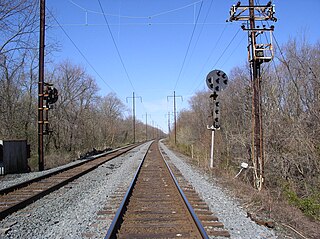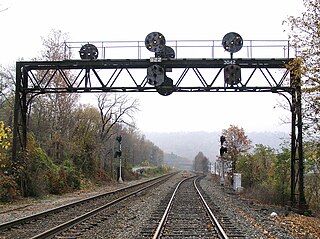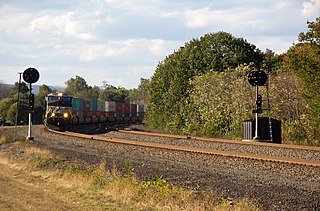The Pennsylvania Railroad, legal name The Pennsylvania Railroad Company also known as the "Pennsy", was an American Class I railroad that was established in 1846 and headquartered in Philadelphia, Pennsylvania. It was named for the commonwealth in which it was established. At its peak in 1882, the Pennsylvania Railroad was the largest railroad, the largest transportation enterprise, and the largest corporation in the world.
The Junction Railroad was a railroad created in 1860 to connect lines west of downtown Philadelphia, Pennsylvania, and allow north-south traffic through the metropolitan area for the first time. The railroad consisted of 3.56 miles of double track and 5.3 miles of sidings. It owned no locomotives or rolling stock. The line connected the Philadelphia and Reading Rail Road line at the west end of the Columbia Bridge over the Schuylkill River, crossed the Pennsylvania Railroad line, ran parallel to Market Street, and turned south to connect with the Philadelphia, Wilmington and Baltimore Railroad at Gray's Ferry.

The Harrisburg Subdivision is a railroad line owned by CSX Transportation in the U.S. state of Pennsylvania. The line is located in the city of Philadelphia, connecting Greenwich Yard and the Philadelphia Subdivision with the Trenton Subdivision along a former Pennsylvania Railroad line. Much of the Harrisburg Subdivision is the High Line or West Philadelphia Elevated along 31st Street over the 30th Street Station area.

The Trenton Subdivision is a railroad line owned by CSX Transportation in the U.S. states of Pennsylvania and New Jersey. The line runs from CP PARK in Philadelphia, Pennsylvania, northeast to Port Reading Junction in Manville, New Jersey, along a former Reading Company line.
The Southern Tier Line is a railroad line owned and operated by the Norfolk Southern Railway in the U.S. states of New York and Pennsylvania. A mostly former Erie Railroad line, it is suggested that the line runs from Suffern, New York northwest to Buffalo, New York as it shares trackage with Metro-North Railroad’s Port Jervis Line from Suffern to Port Jervis; NS owns the Suffern to Port Jervis trackage and leases it to Metro-North so it can maintain it for its Port Jervis Line passenger operation. From its east end, NS has trackage rights south on the New Jersey Transit Main and Bergen County Lines to Conrail's North Jersey Shared Assets Area.

The Lurgan Branch is a railroad line owned and operated by the Norfolk Southern Railway in the U.S. states of Pennsylvania and Maryland. The line is part of the NS Harrisburg Division and runs from Harrisburg, Pennsylvania southwest to Hagerstown, Maryland along former Reading Company and Pennsylvania Railroad lines. Its northeast end is at a junction with the Harrisburg Line, Pittsburgh Line, Royalton Branch, and Amtrak's Keystone Corridor ; its southwest end is at the beginning of the Hagerstown District. At Lemoyne it intersects the Enola Branch.

The Enola Branch is a railroad segment of the Port Road Branch and was a rail line. The Enola Branch railroad segment and the rest of the Port Road Branch is owned and operated by the Norfolk Southern Railway in the U.S. state of Pennsylvania. The railroad segment runs from Washington Boro northwest to Marysville and it is a former Pennsylvania Railroad rail line. Its south end is at a former junction with the Atglen and Susquehanna Branch, where the main segment of the Port Road Branch continues southeast. Its north end is at the Pittsburgh Line. Along the way, it meets the York Secondary at Wago Junction and goes under the Lurgan Branch at Lemoyne. Norfolk Southern labels the Enola Branch as part of the Port Road Branch, officially ending the Enola Branch's existence as a rail line, the main segment of the Port Road Branch runs from Marysville south to Perryville, Maryland. The line goes through the Enola Yard.

The Buffalo Line is a railroad line owned by the Norfolk Southern Railway in the U.S. states of New York and Pennsylvania. The line runs from Buffalo, New York southeast to Rockville, Pennsylvania near Harrisburg, Pennsylvania along a former Pennsylvania Railroad line. Its north end is at Seneca Yard in Buffalo, with no direct access to the Lake Erie district, and its south end is at the Pittsburgh Line at Rockville. The line is operated by the Buffalo and Pittsburgh Railroad between Buffalo and Machias, New York, the Western New York and Pennsylvania Railroad between Machias and Driftwood, Pennsylvania, and the Norfolk Southern Railway between Driftwood and Rockville.
The Dayton District is a railroad line owned and operated by the Norfolk Southern Railway in the U.S. state of Ohio. The line runs from Columbus southwest to Cincinnati along former Pennsylvania Railroad and New York Central Railroad lines. Its east end is at or near the Columbus District, Sandusky District, and West Virginia Secondary; its south end is in Ivorydale, where it meets the Indiana and Ohio Railway's Midland Subdivision, and just past that in Winton Place, where it meets CSX Transportation's Cincinnati Terminal Subdivision. Along the way, it junctions the New Castle District at Evendale.
The Lincoln Secondary is a railroad line owned and operated by Conrail in the U.S. state of Michigan as part of its Conrail Shared Assets Operations.

The Main Line of the Pennsylvania Railroad was a rail line in Pennsylvania connecting Philadelphia with Pittsburgh via Harrisburg. The rail line was split into two rail lines, and now all of its right-of-way is a cross-state corridor, composed of Amtrak's Philadelphia to Harrisburg Main Line and the Norfolk Southern Railway's Pittsburgh Line.

The Port Perry Branch is a rail line owned and operated by the Norfolk Southern Railway in the U.S. state of Pennsylvania. The line runs from the Pittsburgh Line in North Versailles Township southwest through the Port Perry Tunnel and across the Monongahela River on the PRR Port Perry Bridge to the Mon Line in Duquesne along a former Pennsylvania Railroad line.
The Fort Wayne Line and Fort Wayne Secondary is a rail line owned and operated by the Norfolk Southern Railway (NS), Chicago, Fort Wayne and Eastern Railroad (CFE), and CSX Transportation in Pennsylvania, Ohio, and Indiana. The line runs from Pittsburgh, west via Fort Wayne, Indiana, to Gary, Indiana, along what was once the Pennsylvania Railroad's Pittsburgh to Chicago main line.
The Columbus to Chicago Main Line was a rail line owned and operated by the Pennsylvania Railroad in the U.S. states of Ohio, Indiana, and Illinois. The line ran from Columbus, Ohio northwest via Logansport, Indiana to Chicago, Illinois. Junctions included the Columbus to Indianapolis Main Line via Bradford, which split at Bradford to reach the Pittsburgh to St. Louis Main Line at New Paris, Ohio; the Fort Wayne Branch at Ridgeville, Indiana; the Richmond Branch at Anoka, Indiana; and the South Bend Branch and I&F Branch at Logansport.
The Columbus to Indianapolis via Bradford Main Line was a rail line owned and operated by the Pennsylvania Railroad in the U.S. state of Ohio.
The Pittsburgh to St. Louis Main Line was a rail line owned and operated by the Pennsylvania Railroad in the U.S. states of Pennsylvania, Ohio, Indiana, and Illinois. The line ran from Pittsburgh, Pennsylvania west via Steubenville, Ohio, Columbus, Ohio, Dayton, Ohio, Indianapolis, Indiana, Terre Haute, Indiana, and Vandalia, Illinois to East St. Louis, Illinois. In addition to its east end in downtown Pittsburgh, where it met the Main Line and Pittsburgh to Chicago Main Line, junctions included the Columbus to Chicago Main Line at Columbus, the C&X Branch at Xenia, the Columbus to Indianapolis Main Line via Bradford at New Paris, the Richmond Branch and Fort Wayne Branch at Richmond, the Louisville Branch and I&F Branch at Indianapolis, and the Peoria Branch at Farrington, Illinois.
The Delaware Extension was a rail line owned and operated by the Pennsylvania Railroad in Philadelphia, Pennsylvania.
The Kiski Junction Railroad was a short-line railroad that operated in Western Pennsylvania near the city of Pittsburgh. The railroad was based in the small community of Schenley which is situated at the point where the Kiskiminetas River flows into the Allegheny River. The KJR functioned as both a freight hauler and a tourist railroad. The railroad suspended all rail operations after the 2016 season and was officially closed and abandoned in 2021.

Pulse code cab signaling is a form of cab signaling technology developed in the United States by the Union Switch and Signal corporation for the Pennsylvania Railroad in the 1920s. The 4-aspect system widely adopted by the PRR and its successor railroads has become the dominant railroad cab signaling system in North America with versions of the technology also being adopted in Europe and rapid transit systems. In its home territory on former PRR successor Conrail owned lines and on railroads operating under the NORAC Rulebook it is known simply as Cab Signaling System or CSS.

The Pittsburgh Line is the Norfolk Southern Railway's primary east–west artery in its Pittsburgh Division and Harrisburg Division across the U.S. state of Pennsylvania and is part of the Keystone Corridor, Amtrak-Norfolk Southern's combined rail corridor.










